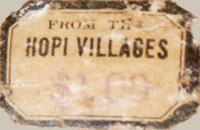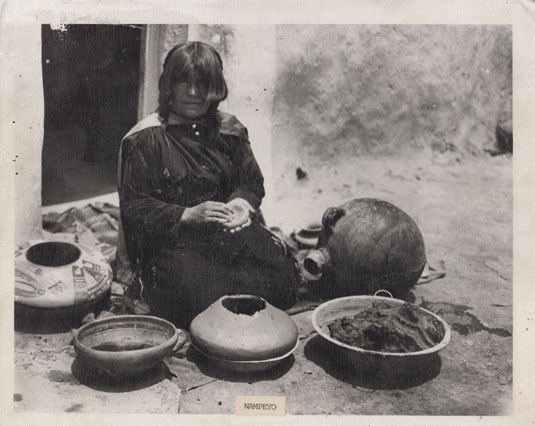Hopi-Tewa Two Slip Colors Nampeyo Jar [SOLD]
+ Add to my watchlist Forward to Friend
- Category: Historic
- Origin: Hopi Pueblo, Hopituh Shi-nu-mu
- Medium: clay, pigment
- Size: 7” tall x 8-⅛” diameter
- Item # C4104D SOLD
“A study of numerous well-documented Nampeyo works reveals that the golden age of her exquisitely decorated work was between the years of 1895 and 1908. Although she continued to produce outstanding pieces of art after 1908, her failing eyesight made it necessary to turn over more of her decorative work to family members.” Blair 1999:90
Nampeyo of Hano was a true artist who constantly experimented with vessel shapes, slips, and designs as if she was not interested in what might be of interest to a buyer, but what she herself wanted to try. This duotone jar is certainly an experiment by Nampeyo with no known precedent. It was probably an experiment she tried around circa 1905, as the only published similar piece is one that was purchased by J. J. Mora at Hopi when he was there in 1904-1907. The caption that accompanies the photograph of the Mora piece states “Two other Nampeyo pots have been located that are slipped in this fashion.” Blair 1999:VII
Nampeyo put two different slips on this jar, dividing the jar in halves. Both slips are traditional on Hopi-Tewa pottery but not used in a similar manner by other potters. The design chosen by Nampeyo is sparse, a design she chose so as not to overwhelm her choice of slips, but to allow the slips to predominate and the design to assist.
The two bear paws at the end of sweeping arches of dark brown pigment were treated differently on the cream slip. The base of the paw was painted red on one and brown on the other. The pendant feather was slipped in red. Nampeyo’s treatment of spreading out the paws at the end of sweeping curves accentuates the width of the body of the jar.
On the other side of the jar, the black-on-red side, the bear paws were treated similarly and the pendant feather was slipped in white. The design on the neck is simply a wide framing line over a thin framing line. Above those are dark brown triangles and a brown rim. The inside of the neck of the jar was painted in the same slips as the exterior. The underside of the jar is similarly slipped in both colors. All of the framing lines feature ceremonial line breaks.
This is a rare example of an early jar by Nampeyo, a jar with which she illustrated her desire to experiment with shapes, slips and designs. It obviously was a period when she was free to so as she wished rather than produce what was in demand.
 There is a paper label that states “From the Hopi Villages” on the lower portion of the jar with a price of only a few dollars, at the time.
There is a paper label that states “From the Hopi Villages” on the lower portion of the jar with a price of only a few dollars, at the time.
Condition: there is a small section of the rim where a chip has been put back in place, and there is a thin slip crack on the neck that does not penetrate the clay to the inside. Overall, it is in very good condition.
Provenance: this Hopi-Tewa Two Slip Colors Nampeyo Jar is from a private collection
Reference: The Legacy of a Master Potter: Nampeyo and Her Descendants by Mary Ellen and Laurence Blair
Image: We are appreciative to Hopi-Tewa potter, Mark Tahbo, for sharing this photograph with us. The photograph was recently found in a burned out home at First Mesa. This image was later identified as having been taken on July 8, 1913, by photographer Joseph K. Dixon. It is part of the Wanamaker Collection of American Indian Photographs at the Mathers Museum of World Cultures, Indiana University, catalog #1962-08-3279.
- Category: Historic
- Origin: Hopi Pueblo, Hopituh Shi-nu-mu
- Medium: clay, pigment
- Size: 7” tall x 8-⅛” diameter
- Item # C4104D SOLD




